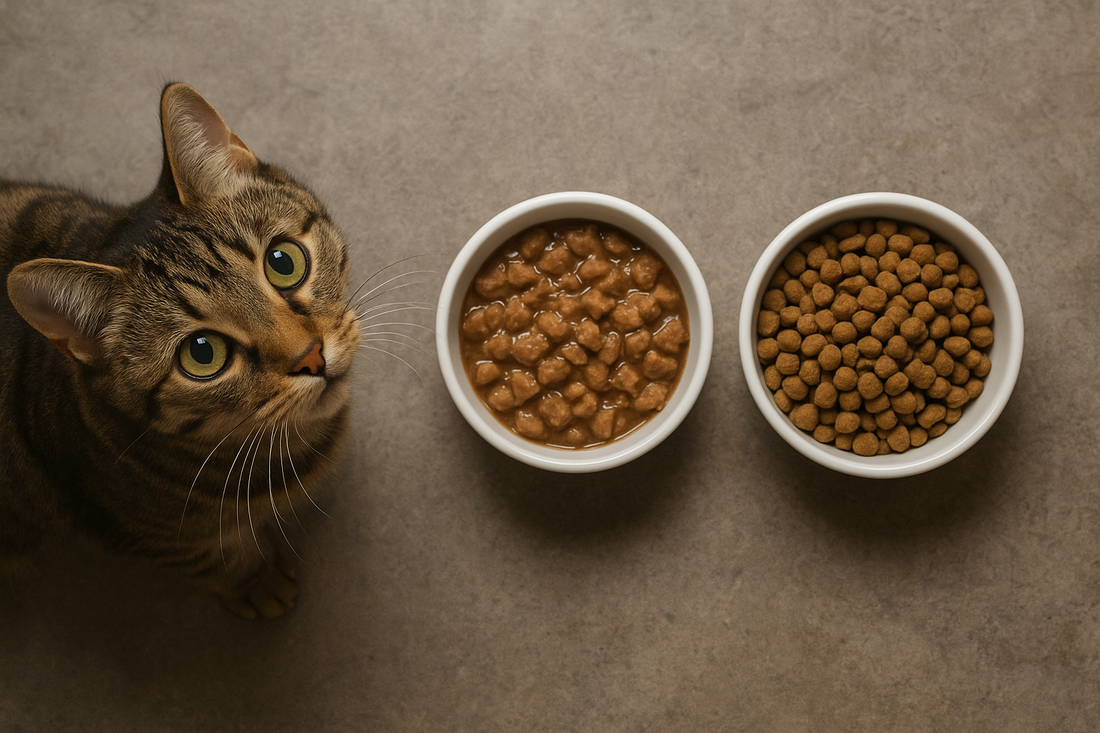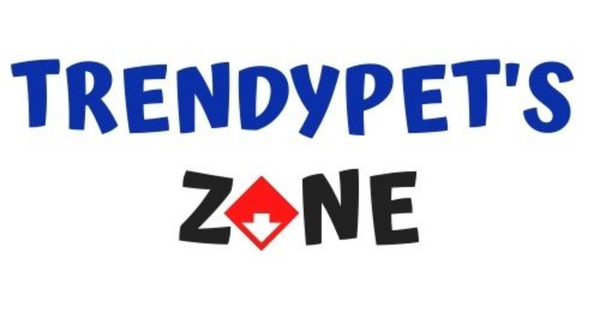
WET VS. DRY CAT FOOD: Which Is Better for Your Cat?
Choosing the right cat food is one of the most important decisions you’ll make as a pet parent. Walk into any American pet store, and you’ll find endless options: wet food, dry kibble, grain-free formulas, prescription diets, and even fresh or freeze-dried meals. Each promises complete nutrition, but with so many choices, many cat owners wonder: Is wet or dry cat food better for my cat?
The answer isn’t simple. Both wet and dry foods have advantages and drawbacks, and the best option depends on your cat’s age, health, activity level, and personal preferences — not to mention your budget and lifestyle. What works for a playful kitten may not suit a senior cat with kidney concerns.
Understanding how each type of food affects your cat’s hydration, weight, digestion, and dental health can help you make a smart, informed decision. This guide breaks down the pros and cons of wet and dry cat food, explores when each is best, and provides expert tips so you can confidently choose a diet that keeps your feline companion healthy and satisfied.
Wet Cat Food
 Wet cat food, also known as canned food, contains a high moisture content and comes in a variety of flavors, textures, and formulations. Many veterinarians recommend wet food for cats that need extra hydration or are prone to urinary or kidney issues.
Wet cat food, also known as canned food, contains a high moisture content and comes in a variety of flavors, textures, and formulations. Many veterinarians recommend wet food for cats that need extra hydration or are prone to urinary or kidney issues.
✅ Pros of Wet Food
Hydration Support:
Cats have a naturally low thirst drive, which means they may not drink enough water on their own. Wet food, containing 70–85% water, helps maintain proper hydration and supports kidney and urinary tract health. This is especially beneficial for cats prone to urinary crystals, kidney disease, or constipation.
Palatability:
The aroma, flavor, and texture of wet food make it highly appealing, especially for picky eaters, senior cats, or cats recovering from illness. Its strong scent often stimulates appetite — a plus for cats with reduced sense of smell or recovering from surgery.
Easier to Chew:
Wet food is soft and gentle on teeth and gums, making it ideal for kittens, senior cats, or cats with dental disease or missing teeth.
High-Protein Options:
Many premium wet foods mimic a cat’s natural diet, with higher protein and lower carbohydrates — perfect for maintaining lean muscle and steady energy.
❌ Cons of Wet Food
Higher Cost:
Wet food can be expensive, especially premium brands like Royal Canin, Hill’s Science Diet, or Blue Buffalo. A typical can ranges from $1–$3 per meal, which can add up quickly for multi-cat households.
Short Shelf Life:
Once opened, wet food must be refrigerated and consumed within 24–48 hours to prevent spoilage.
Messier Feeding:
Wet food can stick to bowls, whiskers, and nearby surfaces, requiring more cleanup. Some cats also dislike cold food, so it’s best to let refrigerated portions reach room temperature before serving.
Environmental Impact:
Canned food often comes in single-use packaging, so it can generate more waste compared to large dry food bags.
Pro Tip for Cat Owners:
👉 Many pet parents feed wet food in combination with dry food to provide hydration while managing costs. For instance, offer wet food for breakfast and dry food for dinner.
Dry Cat Food (Kibble)

 Dry cat food, or kibble, is a staple in many households due to its convenience, affordability, and longer shelf life. It’s low in moisture but calorie-dense, making it easy to measure, store, and feed.
Dry cat food, or kibble, is a staple in many households due to its convenience, affordability, and longer shelf life. It’s low in moisture but calorie-dense, making it easy to measure, store, and feed.
✅ Pros of Dry Food
Convenience:
Dry food can be left out for free-feeding, which suits busy households or cats that prefer grazing throughout the day. It’s also easier to store and doesn’t spoil as quickly as wet food.
Cost-Effective:
On average, dry food costs less per serving than wet food. A 7–10 lb bag can last a month or more, depending on your cat’s size, appetite, and feeding routine.
Dental Benefits:
While not a substitute for brushing, chewing dry food may help reduce plaque buildup and keep teeth cleaner than soft diets alone.
Ease of Portion Control:
Kibble allows for precise portion measurement, which helps with weight management and consistency — especially for cats on calorie-restricted diets.
❌ Cons of Dry Food
Low Moisture Content:
Since dry food contains only about 10% water, cats eating primarily kibble are at greater risk of dehydration and urinary tract problems. Always provide multiple water sources around your home, or consider a cat water fountain to encourage drinking.
Calorie-Dense:
Dry food packs a lot of calories in small servings, making overfeeding easy. This can lead to obesity, one of the most common health issues among indoor cats in the U.S.
Less Palatable:
Some cats prefer wet food and may be reluctant to eat dry kibble alone. Cats transitioning from canned food might take time to adapt.
🐾 Tips for Feeding Dry Food
- Choose kibble appropriate for your cat’s life stage — kitten, adult, or senior.
- Consider grain-free or limited-ingredient formulas if your cat has sensitivities or allergies.
- Mix with a small portion of wet food to increase flavor and hydration.
- Store kibble in a sealed container to preserve freshness and prevent nutrient loss.
⚖️Which Is Better for Your Cat?

 There is no universal answer — it depends on your cat’s unique needs. Many veterinarians recommend a combination feeding approach, which leverages the benefits of both wet and dry foods:
There is no universal answer — it depends on your cat’s unique needs. Many veterinarians recommend a combination feeding approach, which leverages the benefits of both wet and dry foods:
- Wet Food: Provides hydration, flavor variety, and is gentle on teeth.
- Dry Food: Offers convenience, affordability, and helps with portion control.
Factors to Consider When Choosing
1. Age:
⦁ Kittens benefit from wet food for hydration and soft texture.
⦁ Adults often do well on a mix of both.
⦁ Seniors may need extra moisture and easier-to-chew food.
2. Health Conditions:
Cats with kidney disease, urinary issues, diabetes, or obesity often require wet or veterinary diets. Always follow your vet’s dietary recommendations.
3. Preferences:
Cats are notorious for being picky eaters. If your cat refuses one texture, try mixing both types gradually.
4. Feeding Schedule:
Free-feeding dry kibble works for some households, while scheduled wet food meals help control portions and prevent overeating.
Pro Tip:
🐈 A common routine is to feed wet food in the morning and dry food in the evening, or alternate days for variety.
Nutritional Insights: What Really Matters
Beyond texture, the most important factor is nutritional balance. Whether wet or dry, your cat’s food should meet AAFCO (Association of American Feed Control Officials) standards for “complete and balanced” nutrition.
Key Nutrients to Look For:
- High-quality animal protein (chicken, turkey, fish, or beef) as the first ingredient.
- Taurine, an essential amino acid for heart and vision health.
- Omega-3 and Omega-6 fatty acids for coat and skin health.
- Low carbohydrates, as cats are obligate carnivores.
- Added vitamins and minerals to support immune and organ health.
Avoid foods with excess fillers, artificial colors, or unnamed meat by-products. The goal is to feed like nature intended — protein-rich, moisture-balanced, and nutritionally dense meals that fuel your cat’s instinctive energy.
If you’re unsure how much to feed, use the portion guide on the package as a starting point, then adjust based on your cat’s weight, body condition, and activity level. Regular veterinary checkups can help fine-tune your cat’s diet over time.
Considerations for Cat Owners

Here are key points for American cat owners when selecting cat food:
Availability:
Both wet and dry foods are widely available at stores like PetSmart, Petco, Walmart, and online retailers such as Chewy and Amazon. Many brands also offer subscription delivery for convenience.
Popular Brands:
Trusted options include Hill’s Science Diet, Purina Pro Plan, Blue Buffalo, Wellness, and Royal Canin. Always look for the AAFCO statement to ensure the food is nutritionally complete.
Cost & Budgeting Tips:
Dry food is generally cheaper, but buying wet food in bulk or using auto-ship discounts can make it more affordable. Some brands offer “multi-packs” to rotate flavors without waste.
Veterinary Guidance:
Vets often recommend wet food for cats prone to urinary or kidney issues, while dry food may suit cats who need calorie-dense diets or dental maintenance.
Specialty Diets:
If your cat has allergies, weight problems, or digestive sensitivities, look for specialized formulas such as:
- Grain-free or limited-ingredient diets
- Weight-management formulas
-
Urinary or renal support diets
Always consult your veterinarian before switching to a new food.
🐾 Final Thoughts

Both wet and dry cat food have clear benefits. Wet food supports hydration, provides variety, and is gentle on teeth, while dry food is convenient, affordable, and easy to portion.
For most cat owners, a balanced combination tailored to your cat’s age, health, and lifestyle works best. Whether you feed twice a day or leave food out for grazing, consistency and quality matter most.
Always choose a complete and balanced diet formulated for your cat’s life stage, offer plenty of fresh water, and schedule annual vet visits to monitor health and weight. Small changes — like switching textures or adding a few spoonful of wet food daily — can make a big difference in long-term well-being.
By understanding the benefits and drawbacks of each type of food, you can confidently choose a diet that keeps your cat happy, hydrated, and thriving — for years to come. After all, a healthy cat is a happy cat, and nothing feels better than seeing your furry friend purr with contentment after a satisfying meal.
Tags: Best cat food USA, best litter box for cats, Cat diet guide, Cat hydration and health, Cat nutrition tips, Dry cat food pros and cons, U.S. cat food brands, Wet cat food benefits, Wet vs dry cat food, Best Cat Food for Health, Cat Nutrition Guide, Combination Feeding for Cats, Cat Feeding Guide, Choosing Cat Food, Cat Hydration and Nutrition, Cat Food Comparison, Veterinarian Recommended Cat Food, Cat Food Buying Guide, Healthy Cat Diet Tips, Indoor Cat Diet Tips
